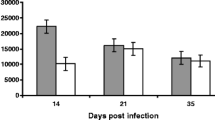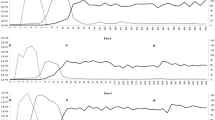Abstract
Lactation in sheep and mice was associated with a marked increase in susceptibility to newly acquired infection withHaemonchus contortus andNematospiroides dubius, respectively. In sheep this increased susceptibility to infection withH. contortus occurred in late pregnancy and during lactation and was seen when the ewes were infected with both a single large dose of infective larvae and a “trickle” infection of 200 and 400 infective larvae ofH. contortus given weekly for 14 weeks. Nonlactating ewes whose lactation had been terminated were able to reject the parasites which had been acquired in late pregnancy.
A relaxation in the protective immune response was evident in immunized mice infected during lactation withN. dubius. However, despite this periparturient relaxation of immunity mice were capable of inducing a marked passive transfer of immunity to their offspring. Thus, neonatal mice born of mothers one or two months after the end of the immunizing schedule were protected against infection withN. dubius at 12 or 20 days of age.
Similar content being viewed by others
References
Bartlett A, Ball PAJ (1974) The immune response of the mouse to larvae and adults ofNematospiroides dubius. Int J Parasitol 4:463–470
Behnke JM, Parish HA (1979)Nematospiroides dubius: arrested development of larvae in immune mice. Exp Parasitol 47:116–127
Behnke JM, Wakelin D (1977)Nematospiroides dubius: stimulation of acquired immunity in inbred strains of mice. J Helminthol 51:167–176
Burrells C, Wells PW, Sutherland AD (1978) Reactivity of ovine lymphocytes to phytohaemagglutinin and pokeweed mitogen during pregnancy and in the immediate post-parturient period. Clin Exp Immunol 33:410–415
Burren CH (1980) A method of obtaining large numbers of clean infective larvae ofNematospiroides dubius. Z Parasitenkd 62:111–112
Chen P, Soulsby EJL (1976)Haemonchus contortus infection in ewes: blastogenic responses of peripheral blood leukocytes to third stage larval antigen. Int J Parasitol 6:135–141
Chiamcumpa V, Jenkin CR, Rowley D (1976) Passive transfer of immunity to infection withNematospiroides dubius from immunized mice to their offspring. Aust J Exp Biol Med Sci 54:245–252
Connan RM (1968) Studies on the worm populations in the alimentary tract of breeding ewes. J Helminthol 42:9–28
Connan RM (1970) The effect of host lactation on the self-cure ofNippostrongylus brasiliensis in rats. Parasitology 61:27–33
Connan RM (1971)Hyostrongylus rubidus: the size and structure of adult worm populations in adult pigs. Vet Rec 87:186–191
Connan RM (1972) The effect of host lactation on a second infection ofNippostrongylus brasiliensis in rats. Parasitology 64:229–233
Dineen JK, Kelly JD (1972) The suppression of rejection ofNippostrongylus brasiliensis in lactating rats: the nature of the immunological defect. Immunology 22:1–12
Greenberg Z (1971) Passive transfer of immunity toNippostrongylus brasiliensis (Travassos, 1914) from mother rats to offspring. J Parasitol 57:685–687
Jacobs DE, Dunn JM (1968) The epidemiology of porcine oesophagostomiasis. Nord Vet Med 20:258–266
Jones CE, Rubin R (1974)Nematospiroides dubius: mechanisms of host immunity: 1. Parasite counts, histology, and serum transfer involving orally or subcutaneously sensitized rats. Exp Parasitol 35:434–452
Michel JF, Lancaster MB, Hong C (1979) The effect of age, acquired resistance, pregnancy and lactation on some reactions of cattle to infection withOstertagia ostertagi. Parasitology 79:157–168
Ngwenya BZ (1977) Response of nonsensitized and sensitized lactating mice to infection withTrichinella spiralis. Int J Parasitol 7:41–45
O'Sullivan BM (1974) Effects of lactation onTrichostrongylus colubriformis infections in the guinea pig. Int J Parasitol 4:177–181
O'Sullivan BM, Donald AD (1970) A field study of nematode parasite populations in the lactating ewe. Parasitology 61:301–315
O'Sullivan BM, Donald AD (1973) Responses to infection withHaemonchus contortus andTrichostrongylus colubriformis in ewes of different reproductive status. Int J Parasitol 3:521–530
Selby GR, Wakelin D (1975) Suppression of the immune response toTrichuris muris in lactating mice. Parasitology 71:77–85
Author information
Authors and Affiliations
Rights and permissions
About this article
Cite this article
Shubber, A.H., Lloyd, S. & Soulsby, E.J.L. Infection with gastrointestinal helminths. Effect of lactation and maternal transfer of immunity. Z. Parasitenkd. 65, 181–189 (1981). https://doi.org/10.1007/BF00929184
Received:
Issue Date:
DOI: https://doi.org/10.1007/BF00929184




